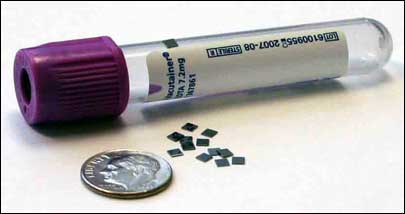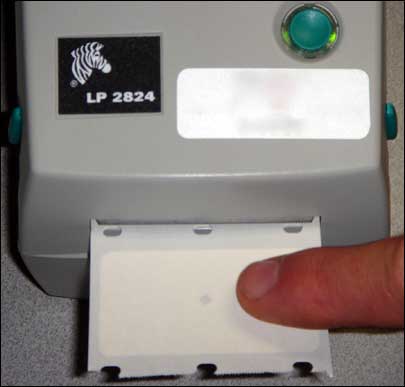Silicon Valley startup company Tagent had developed an ultra-wideband (UWB) passive tag RFID system that will be piloted this summer at a California medical lab. The new system, according to Geoff Zawolkow, the company’s VP of marketing and business development, will offer a locating capability and read range comparable to that of an active UWB tag, but in a form factor and price that would allow them to attach the tags to disposable labels.
The Talon system features the Talon Integrated RTLS Tag, a 2-millimeter (0.1-inch) passive RFID chip with a built-in antenna. The system also includes a specially designed RFID interrogator, as well as a network of power nodes that emit a 5.8 GHz RF signal that energizes the tags. The power nodes, deployed 2 meters (6.6 feet) apart from one another, can also be used to determine a chip’s location.

The tag has 128 bits of read-only memory. According to Zawolkow, the tag came out of assembly this month, and Tagent has been testing it in-house. The tests, he says, have proven the technology works, and the company intends to begin a pilot at an unnamed California medical laboratory this summer, by embedding the tag on labels attached to blood tubes. In addition, he notes, several other similar pilots are scheduled to take place later this year, in other parts of the world. If the initial pilots go well, Tagent intends to begin selling the chips commercially by August or September.
Here’s how the system works: A Tagent reader transmits a 2.4 GHz signal instructing a specific power node to emit its 5.8 GHz signal. The node transmission can be picked up by a tag up to 1 meter (3.3 feet) away, or the strength of the node’s signal can be adjusted to a shorter range to further pinpoint the tag’s location. Any tag within that node’s transmission range then emits its own 6.7 GHz signal, which can be received by a Tagent reader up to 20 meters (65.6 feet) away.
Because the tag responded, following the instruction, to a specific power node, and because the system knows that power node’s location, the system can also deduce that the tag is located within 1 meter (3.3 feet) of that power node. The reader is typically wired to the back-end server via an Ethernet cable. Web-based Tagent software links the RFID tag’s ID number with the power node and its location, thereby identifying the tag’s whereabouts based on that information. It then displays the location to within several meters (or less, if the node’s power has been dialed down to provide greater RTLS accuracy), which represents the 2-meter-wide (6.6-foot-wide) spherical space circumscribed by the power node’s RF signal. This provides a real-time location system, since the reader can instruct the nodes to pulse very frequently (every second, for instance).The system can be deployed in a number of different ways, Zawolkow says, depending on the application, and can include portals, an RTLS network, or both.
Because of its small size, the tag presents an advantage to users who might want the benefits of active UWB RFID tags (longer read range and RTLS) but who may find a battery-powered tag too large or expensive. The Talon tag will be especially useful for the lab test-tube market, Zawolkow indicates, in which active tags would not fit on the tube. In this case, for the pending pilot, Tagent will embed the RFID tags in the adhesive labels currently used by the laboratory. Those labels are printed with a patient’s name and serial number, both in text and in bar-code form. Labs typically track their tubes, and the samples they contain, by reading the names and ID numbers printed on those labels, or by scanning the labels’ bar codes. That system, however, does not allow for real-time location, which could be useful, for example, when there is a search for a specific blood sample.
In the case of the lab pilot, blood will be drawn and placed in the tubes. Each tube’s RFID tag number is read at the time the information is input into the lab’s back-end software system, linking that data to the RFID tag in the label. As they leave one location and are taken to another laboratory for testing and storage, the tubes will then pass by interrogators at several portals, consisting of two to four (or more) power nodes and a reader.
“We will be experimenting with the configuration of power nodes in the portals,” Zawolkow states.
Although the tubes are in storage units, such as refrigeration, the grid of power nodes and readers deployed in the area will continually capture their location. In that way, Zawolkow says, if a blood sample needs to be accessed immediately, it can be located by logging onto a Web-based software system provided by Tagent, then viewing a display that locates the blood sample.The RTLS granularity is necessary in many large blood labs, Zawolkow says, where thousands of blood samples are processed daily. Many have extremely large refrigeration units, as well as large tabletop areas on which the samples are processed, and locating a specific tube in such an environment can thus be time-consuming. Approximately 1,000 labs in the United States process 4,000 samples or more each day in a 10,000-square-foot area, Zawolkow says, and the lab in which the pilot will take place processes closer to 6,000 samples. A typical deployment in a lab of this size, he notes, would require 350 power nodes and roughly 10 readers.
Tagent has been working on this product for about four years, Zawolkow says, in order to reduce the price and size of the tag. Currently, he adds, the company hopes to list the tag for approximately 30 cents apiece, with power nodes costing about $50, and readers between $1,500 and $2,000.
According to Zawolkow, the system can also be used for tracking manufactured goods through a factory. What’s more, he indicates, it may be tested in the near future by an unnamed semiconductor manufacturer. The tag would be embedded in semiconductor tag packaging, and when the semiconductors are tested for performance, and sorted according to that performance, the RFID tag could help the company’s staff link multiple semiconductors of the same performance level together in a single bin.
Power nodes can be battery-powered, Zawolkow says, but will more frequently be plugged into an AC power outlet.
Research and development company Martec Corp. is also developing a passive UWB tag, known as Passpulse (see R&D Firm Developing Passive Ultra-Wideband RFID). Like the Tagent tag, the Passpulse tag is designed to be powered entirely by incoming radio frequency signals; in this case, however, the power comes directly from the interrogator. The launch date for Passpulse was initially scheduled for late 2009. A spokesperson for Martec indicates he can not confirm that launch date, but says the development is continuing.


